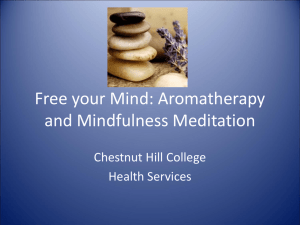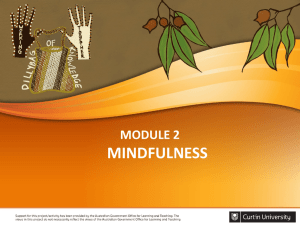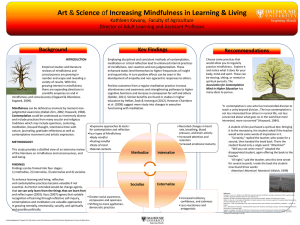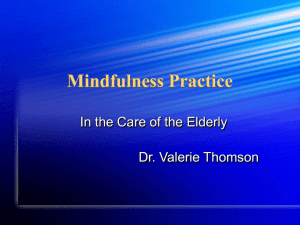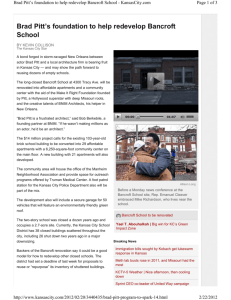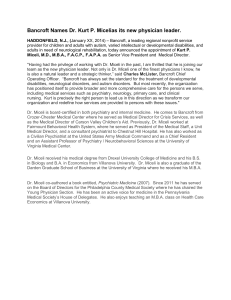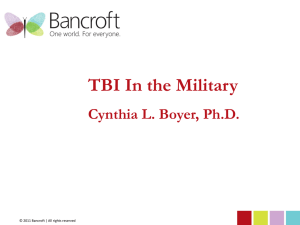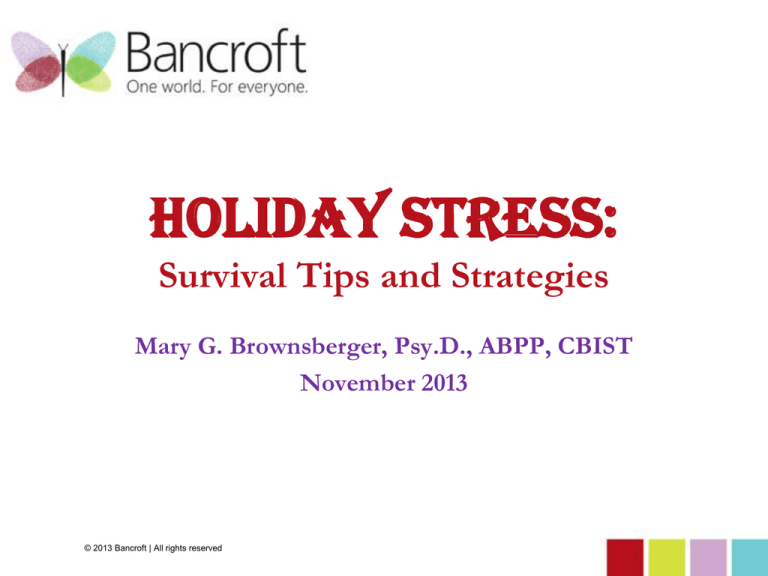
Holiday Stress:
Survival Tips and Strategies
Mary G. Brownsberger, Psy.D., ABPP, CBIST
November 2013
© 2013 Bancroft | All rights reserved
Happy Holidays
Our Ideal Images
Common Stress Triggers
• “Ideal” vs. “Reality”
– Extra tasks, activities
– Grief, guilt
– Change in routine
– Financial concerns
– Strained relationships
• For brain injury
survivors:
physical , cognitive,
emotional
challenges reduce
capacity to manage
stress
• And what about
family members
and caregivers for
brain injury
survivors?
STRESS!!
Acute Stress
• Fight, flight, freeze!
– Increased blood
pressure
– Increased pulse
– Increased breathing
rate
– Increased inflammation
– Decreased gastrointestinal function
Chronic Stress
•
•
•
•
High Blood Pressure
Heart arrythmias
Sleep disorders
Chronic headache,
backache
• Anxiety, depression
• Immune dysfunction
• Self-destructive behaviors
– Overwork, Substance use
Suicide
Holiday Suicides: Fact or Myth?
•
•
•
The idea that suicides occur more frequently during the holiday season is a
long perpetuated myth. The Annenberg Public Policy Center has been
tracking media reports on suicide since 2000. A recent analysis found that
50% of articles written during the 2009–2010 holiday season perpetuated the
myth.1
CDC’s National Center for Health Statistics reports that the suicide rate is, in
fact, the lowest in December.2 The rate peaks in the spring and the fall.
This pattern has not changed in recent years. The holiday suicide myth
supports misinformation about suicide that might ultimately hamper
prevention efforts.
Suicide remains a major public health problem, one that occurs
throughout the year. It is the 10th leading cause of death for all Americans.
Each year, more than 36,000 people take their own lives.2 In addition, more
than 374,000 are treated in emergency departments for self-inflicted injuries.
An Evidence-based
Framework for Understanding
Stress Reaction and Stress
Response
ICF Framework
© 2013 Bancroft | All rights reserved
Using the ICF to Understand
Holiday Stress
• What are environmental factors that
impact stress levels?
• What are personal factors?
• What health condition factors?
• How have our roles changed post-injury?
• What are our “go to” stress management
strategies?
Environmental Factors
• Weather
• Different location than routine
– Accessibility
– Travel stressors
• Who is around us that is different from
routine
Personal Factors
•
•
•
•
Anxiety
Depression
Personality (introverted, extraverted)
Adaptability to change
Health Factors
• Physical functioning
– Mobility
– Chronic pain
– Fatigue
• Cognitive functioning
– Attention
– Memory
– Fatigue
• Emotional/Behavioral functioning
– Labile emotions
– Impulsivity
Role Changes
• What were roles/responsibilities pre-
injury?
– Are there “productive” post-injury roles?
– What’s possible? How to carve out typical
tasks (e.g., if I can’t set the whole table, can I
carry a fork?)
• Hallet et al, 1994:
– Most role changes post-TBI were losses (71%)
– Over 64% participants reported 3 – 4 role
losses
“Between stimulus and
response there is a space. In
that space is our power to
choose our response. In our
response lies our growth and
our freedom.”
Victor Frankl, Man’s Search for Meaning
© 2013 Bancroft | All rights reserved
Stress Reaction
© 2012 Bancroft | All rights reserved
Stress Response
Generally Unhealthy
(Stress Reaction)
Generally Healthy
(Stress Response)
• Alcohol
• Other substances
(prescribed or illicit)
• Rumination
• Physical exercise
– “coulda, shoulda, woulda”
• Worry
• Extra push to meet others’
expectations
• Pushing others away
• Junk food
– Walking, jogging
– Yoga
– Martial arts
•
•
•
•
•
•
Talking to a trusted person
Extra rest time
Healthy food
Spiritual traditions
Meditation/mindfulness
Practice generosity,
compassion
Tips from the Mayo Clinic
• Acknowledge your
feelings.
• Reach out.
• Be realistic.
• Set aside
differences.
• Stick to a budget.
• Plan ahead.
• Learn to say no.
• Don't abandon
healthy habits.
• Take a breather.
• Seek professional
help if you need it.
Tips from Lee Woodruff – for
those of us who care for others
•
•
•
•
•
•
•
•
•
•
Don’t hang back – make contact
Help people feel ‘normal’ – allow people to be helpers as well as
“helpees”
Recognize power of human touch – as people feel comfortable
Establish healthy information exchange – be aware of non-verbal signals
– too much? Too little?
Avoid overmothering
Be sensitive to what people need to hear – validate emotions, peoples’
capacity to handle tough situations – without overdoing it
Think practically about what people really need
Choose words and actions wisely
Understand where faith belongs – respect different values, cultures
Be there for the long haul
What is Mindfulness?
• The non-
judgmental
cultivation of
attention and
awareness
– Actual experience vs.
interpretation or
elaboration
© 2013 Bancroft | All rights reserved
Why Mindfulness for Holiday
Stress?
• Some things are difficult to change
– Environmental factors
– Personal factors
– Health factors
• What we CAN change
– How we respond
© 2013 Bancroft | All rights reserved
Mindfulness-Based Stress
Reduction
• We ALL experience stress
• MBSR helps us self-regulate our
response to stress vs. involuntary
reactions
© 2013 Bancroft | All rights reserved
Recent Research (APA, 2012)
Cognitive/physical
benefits
• Reduced rumination
• Improved working memory
• Improved sustained
attention, ability to focus
• Increased cognitive
flexibility
• Increased information
processing speed
• Increased immune
functioning
© 2013 Bancroft | All rights reserved
Psychological benefits
• Increased emotion
regulation (decreased
depression, anxiety,
emotional reactivity)
• Increased relationship
satisfaction
• Enhanced self-awareness
• Increased empathy,
compassion
Mindfulness Changes Brain
Structure (Gray Matter)
• Levels of perceived stress and related structural
changes in amygdala (Holzel et al, 2010)
• Thicker gray matter in areas related to pain
sensitivity resulting in reduced pain sensitivity
(Grant et al, 2010)
• Increased cortical gyrification (creases and
folds) in areas related to attention, emotion
regulation (Luders et al, 2012)
Mindfulness changes Brain
Function (White Matter)
• Changes in gamma bands (EEG) related to
“mind wandering,” self-reference, attention
(Berkovich-Ohana, et al, 2012)
• Increases in markers of attentional control
(Moore, et al, 2012)
• Increased connectivity of attentional networks
– shifting and sustaining attention (Hasenkamp
et al, 2012)
• Changes in self-regulation networks (Tang et al,
2012)
Two functional brain scans of the author’s brain: a baseline scan and one done while meditating.
These show metabolic activity—red is most active, black is inactive. The one done while meditating
shows a different pattern of metabolic activity. “This shows that meditation doesn’t just affect our
mind—it changes the way that the brain works,” Michael Baime says.
How to apply to holiday stress
•
•
•
•
Time management
“No” is a complete sentence
Rolling with change – without judging
Imperfect is ok
Important concepts
• There is more RIGHT with you than
wrong
• Simply notice what IS
– (vs. analyzing, having opinions)
• We are all works in progress
– Ongoing, life-long learning
© 2013 Bancroft | All rights reserved
Important concepts
• Be kind to yourself
• Integrate practice with life
• The “ideal” will NEVER happen
– So show up – even if not perfect or prefer
not to
© 2013 Bancroft | All rights reserved
Getting started
• Comfortable posture
– sitting or lying
down
• Close eyes
• Attention to belly
• Focus on breath – in
and out
• If mind wanders,
invite back to watch
breath
© 2013 Bancroft | All rights reserved
© 2013 Bancroft | All rights reserved
Resources
I’ll Carry the Fork, Kara Swanson, 1999
Where is the Mango Princess, Cathy Crimmins, 2000
In an Instant, Lee and Bob Woodruff, 2007
Perfectly Imperfect, Lee Woodruff, 2009
Wherever You Go, There You Are, Jon Kabat-Zinn, 1994
Mindfulness for Beginners CD set, Kabat-Zinn
Center for Mindfulness:
http://www.umassmed.edu/content.aspx?id=41252
• Penn Program for Mindfulness:
http://www.pennmedicine.org/stress/
• Jefferson Mindfulness Institute:
http://www.jeffersonhospital.org/cim/article5030.html
•
•
•
•
•
•
•
© 2013 Bancroft | All rights reserved
References
•
•
•
•
•
•
•
•
Baime, M. (2011). This is your brain on mindfulness. Shambhala Sun, July
2011.
Berkovich-Ohana, A., Glicksohn, J., Goldstein, A. (2012). Mindfulnessinduced changes in gamma band activity – Implications for the default mode
network, self-reference and attention. Clinical Neurophysiology, 123 (2012), 700710.
CDC: http://www.cdc.gov/ViolencePrevention/suicide/holiday.html
Davis, D. M., Hayes, J. A. (2012) What are the benefits of mindfulness. APA
(online, www.apa.org).
Grant, J. A., et al. (2010). Cortical thickness and pain sensitivity in Zen
meditators. Emotion, 10 (1), 43-53.
Hasenkamp, W., Barsalou, L. (2012). Effects of meditation experience on
functional connectivity of distributed brain networks. Frontiers in Human
Neuroscience, 6 (38), 1-14.
Holzel, B. K., et al (2012). Stress reduction correlates with structural changes
in the amygdala. SCAN, 2010 (5), 11-17.
Kabat-Zinn, J. (1990/2005). Full Catastrophe Living. Bantam Dell, NY, NY.
© 2013 Bancroft | All rights reserved
References (con’t)
•
•
•
Luders, E., et al. (2012). The unique brain anatomy of meditation
practitioners: alterations in cortical gyrification. Frontiers in Human Neuroscience,
6 (34), 1-9.
Moore, a., Gruber, T., Derose, J., Malinowski, P. (2012). Regular, brief
mindfulness meditation practice improves electrophysiological markers of
attentional control. Frontiers in Human Neuroscience, 6 (18), 1-15.
Tang, Y., Lu, Q., Fan, M., Yang, Y., Posner, M. I. (2012). Mechanisms of
white matter changes induced by meditation. PNAS, 109 (26), 10570-10574.
Be Well.
© 2013 Bancroft | All rights reserved

